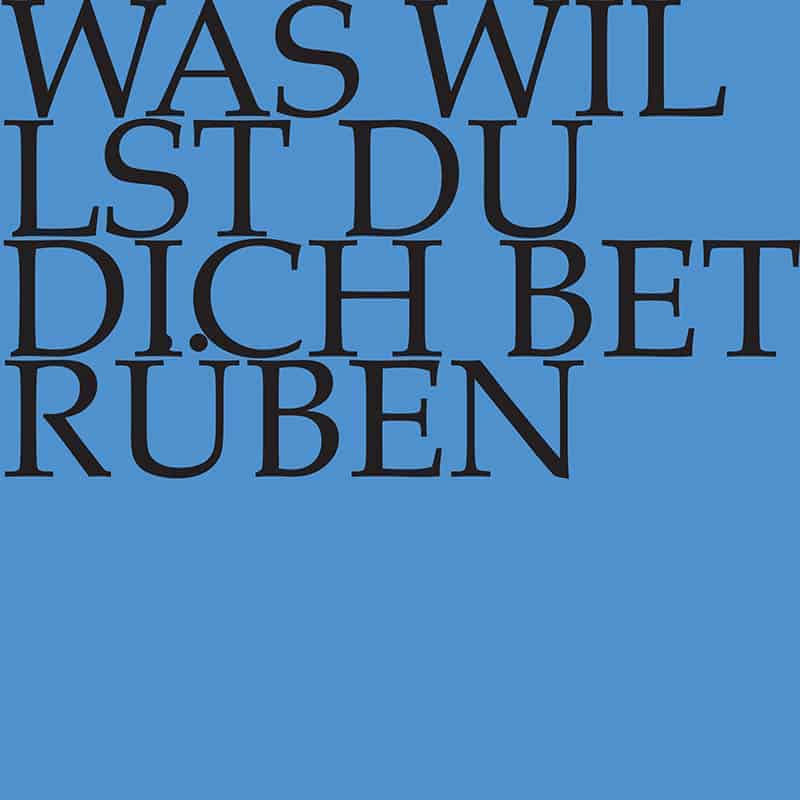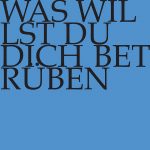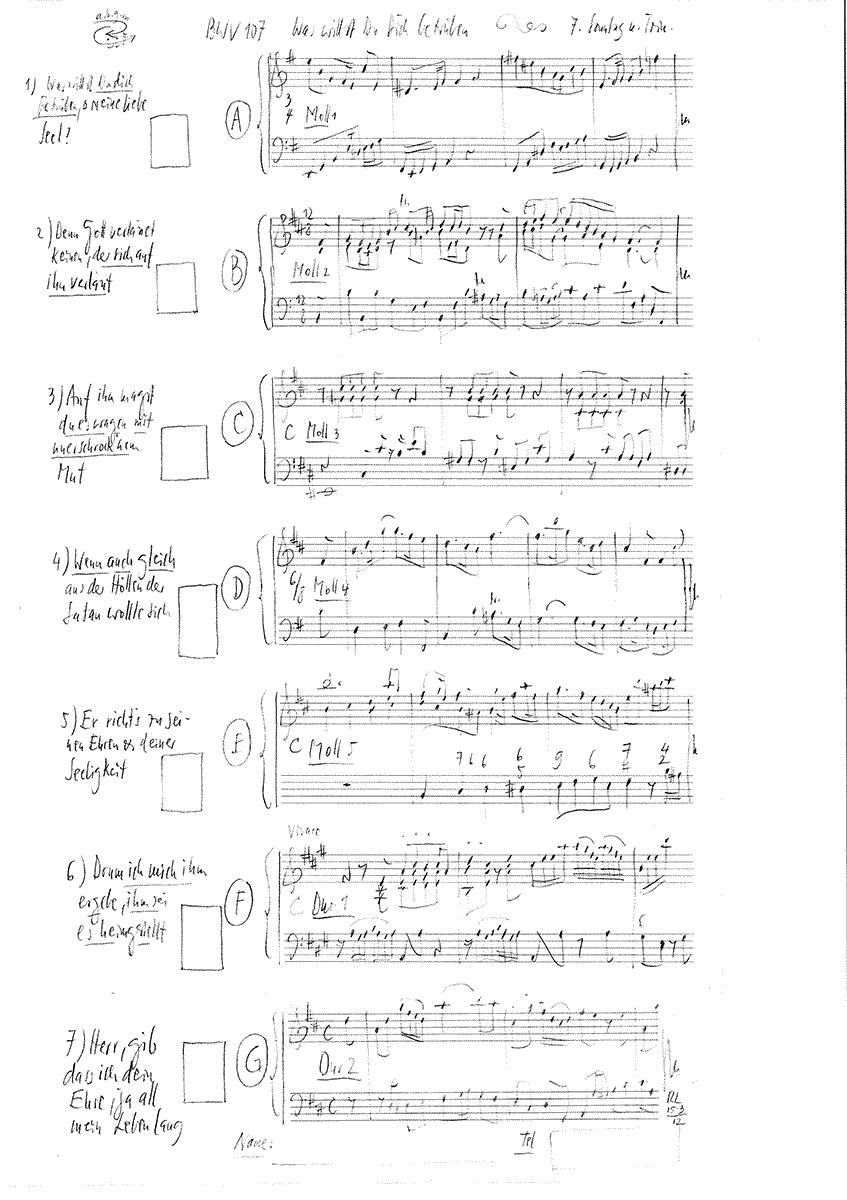Was willst du dich betrüben
BWV 107 // For the Seventh Sunday after Trinity
(Why wouldst thou then be saddened) for soprano, tenor and bass, vocal ensemble, transverse flute I+II, oboe d‘amore I+II, cornett, bassoon, strings and continuo
Composed for the Seventh Sunday after Trinity in 1724, all movements of the cantata “Was willst du dich betrüben” (Why wouldst thou then be saddened) are based on the hymn of the same name by Johann Heermann. This libretto posed the composer with a particular challenge: because he could not rely on contrasting speech rhythms for variety, nor use the modern recitative and aria form to imbue the neutral, yet binding world of the hymn with subjective interpretation, he had to rely on musical means alone to achieve distinction. As the cantata shows, Bach masters this challenge with a steady and audibly light hand.

Das Werk im Kirchenjahr
Perikopen zum Sonntag
Perikopen spiegeln die biblischen Lesungen des jeweiligen Kirchensonntags wider, für den J. S. Bach komponierte. Weitere Infos zu Perikopen
Der Herr erhält alle, die da fallen, und richtet auf alle, die niedergeschlagen sind. Aller Augen warten auf dich, und du gibst ihnen ihre Speise zu seiner Zeit. Du tust deine Hand auf und erfüllest alles, was lebt, mit Wohlgefallen.
Ich muss menschlich davon reden um der Schwachheit willen eures Fleisches. Gleichwie ihr eure Glieder begeben habet zum Dienst der Unreinigkeit und von einer Ungerechtigkeit zu der andern, also begebet auch nun eure Glieder zum Dienst der Gerechtigkeit, dass sie heilig werden. Denn da ihr der Sünde Knechte waret, da waret ihr frei von der Gerechtigkeit. Was hattet ihr nun zu der Zeit für Frucht? Welcher ihr euch jetzt schämet, denn ihr Ende ist der Tod. Nun ihr aber seid von der Sünde frei und Gottes Knechte geworden, habt ihr eure Frucht, dass ihr heilig werdet, das Ende aber das ewige Leben. Denn der Tod ist der Sünde Sold; aber die Gabe Gottes ist das ewige Leben in Christo Jesu, unserem Herrn.
Zu der Zeit, da viel Volks da war und hatten nichts zu essen, rief Jesus seine Jünger zu sich und sprach zu ihnen: «Mich jammert des Volks; denn sie haben nun drei Tage bei mir beharrt und haben nichts zu essen; und wenn ich sie ungegessen von mir heim liesse gehen, würden sie auf dem Wege verschmachten; denn etliche sind von ferne gekommen.» Seine Jünger antworteten ihm: «Woher nehmen wir Brot hier in der Wüste, dass wir sie sättigen?» Und er fragte sie: «Wie viel habt ihr Brote?» Sie sprachen: «Sieben.» Und er gebot dem Volk, dass sie sich auf der Erde lagerten. Und er nahm die sieben Brote und dankte und brach sie und gab sie seinen Jüngern, dass sie dieselben vorlegten; und sie legten dem Volk vor. Und hatten ein wenig Fischlein; und er dankte und hiess die auch vortragen. Sie aber assen und wurden satt und hoben die übrigen Brocken auf, sieben Körbe. Und ihrer waren bei viertausend, die da gegessen hatten; und er liess sie von sich. 156
Would you like to enjoy our videos ad-free? Subscribe to YouTube Premium now...
Workshop
Reflective lecture
Choir
Soprano
Susanne Frei, Guro Hjemli, Noëmi Tran Rediger, Olivia Fündeling
Alto
Jan Börner, Francisca Näf, Damaris Nussbaumer, Simon Savoy
Tenor
Raphael Höhn, Nicolas Savoy, Walter Siegel
Bass
Oliver Rudin, Philippe Rayot, William Wood
Orchestra
Conductor
Rudolf Lutz
Violin
Renate Steinmann, Dorothee Mühleisen, Monika Baer, Christine Baumann, Eveleen Olsen, Ildiko Sajgo
Viola
Susanna Hefti, Martina Bischof
Violoncello
Maya Amrein, Claire Pottinger
Violone
Iris Finkbeiner
Oboe d’amore
Katharina Arfken, Dominik Melicharek
Bassoon
Susann Landert
Transverse flute
Claire Genewein, Renate Sudhaus
Cornett
Frithjof Smith
Organ
Norbert Zeilberger
Harpsichord
Nicola Cumer
Musical director & conductor
Rudolf Lutz
Workshop
Participants
Karl Graf, Rudolf Lutz
Reflective lecture
Speaker
Ernst Pöppel
Recording & editing
Recording date
03/16/2012
Recording location
Trogen
Sound engineer
Stefan Ritzenthaler
Director
Meinrad Keel
Production manager
Johannes Widmer
Production
GALLUS MEDIA AG, Switzerland
Producer
J.S. Bach Foundation of St. Gallen, Switzerland
Librettist
Text
Johann Heermann (1585–1647)
First performance
Seventh Sunday after Trinity,
23 July 1724
In-depth analysis
The mood of the introductory chorus underscores not the deliverance from distress treated in the hymn text, but the element of “sadness”. Set in an elegiac B minor with no continuo support, the movement opens with a hesitant ascending line from the flute and first oboe d’amore. This line is subsequently taken up by other parts, melding into a sighing play of lines among the woodwinds in intense thirds and sixths. That Bach sets a violin obbligato soaring above this burdened opening gives the work a hint of the sublime, thereby calling to mind the helping hand of Emmanuel – “God is with us!” – that is extended to those in greatest need. Given this setting, the choir is free to deliver the hymn unadorned, enfolded and carried by the orchestra.
In the following bass recitative, Bach reconciles the linear form of the hymn with a more recitative-like style through the measured, oboe d’amore accompaniment and an arioso a tempo setting of the closing line “how God will rescue thee”. The four ensuing arias are highly contrasting in their settings: because a da capo form must be eschewed as unworkable with the hymn text, the path has instead been freed for flowing transitions. In addition to Bach’s clever planning of the overall key structure, he marks the cantata with efficient continuo motifs that charge each movement with a distinctive energy. With its full, string ensemble sound and triumphant coloraturas, the bass aria in A major evokes a heroic atmosphere, while the tenor aria, accompanied solely by the continuo and characterised by contrary motion passages treats the theme of the devil and hell. Here, the energetically leaping E minor bass motive does not so much describe an adversarial threat, but a fighting determination to prevail through trust in the promise of heaven. Two oboes d’amore and a buoyant continuo lend the succeeding soprano aria in B minor a pastoral character that centres on the key word “blessedness”. That humankind must, however, bend to God’s will is made abundantly clear in the aria’s more serious B section and the hymn text “For what God wills is done!” By contrast, the tenor seems to virtually float free of all resistance and angst in his second aria (D major), in which the unison setting of two transverse flutes and a muted violin with a pizzicato continuo provide for a strikingly elegant accompaniment.
Through an independent orchestral part in 6⁄8 time, Bach lends the chorale verse a serious, yet animated character that is well-suited for a prayer supplicating for the strength to praise God forevermore – indeed, Bach’s chorale setting effectively removes all sadness from the believers’ hearts.
Libretto
1. Choral
Was willst du dich betrüben,
o meine liebe Seel?
Ergib dich, den zu lieben,
der heisst Immanuel!
Vertraue ihm allein,
er wird gut alles machen
und fördern deine Sachen,
wie dirs wird selig sein!
2. Rezitativ (Bass)
Denn Gott verlässet keinen,
der sich auf ihn verlässt,
er bleibt getreu den Seinen,
die ihm vertrauen fest.
Lässt sichs an wunderlich,
so lass dir doch nicht grauen!
Mit Freuden wirst du schauen,
wie Gott wird retten dich.
3. Arie (Bass)
Auf ihn magst du es wagen
mit unerschrocknem Mut,
du wirst mit ihm erjagen,
was dir ist nütz und gut.
Was Gott beschlossen hat,
das kann niemand hindern
aus allen Menschenkindern,
es geht nach seinem Rat.
4. Arie (Tenor)
Wenn auch gleich aus der Höllen
der Satan wollte sich
dir selbst entgegenstellen
und toben wider dich,
so muss er doch mit Spott
von seinen Ränken lassen,
damit er dich will fassen;
denn dein Werk fördert Gott.
5. Arie (Sopran)
Er richts zu seinen Ehren
und deiner Seligkeit;
solls sein, kein Mensch kanns wehren,
und wärs ihm doch so leid.
Wills denn Gott haben nicht,
so kanns Niemand forttreiben,
es muss zurükkebleiben,
was Gott will, das geschicht.
6. Arie (Tenor)
Drum ich mich ihm ergebe,
ihm sei es heimgestellt;
nach nichts ich sonst mehr strebe,
denn nur was ihm gefällt.
Drauf wart ich und bin still,
sein Will der ist der beste,
das glaub ich steif und feste,
Gott mach es, wie er will!
7. Choral
Herr, gib, dass ich dein Ehre
ja all mein Leben lang
von Herzengrund vermehre,
dir sage Lob und Dank!
O Vater, Sohn und Geist,
der du aus lauter Gnaden
abwendest Not und Schaden,
sei immerdar gepreist!





